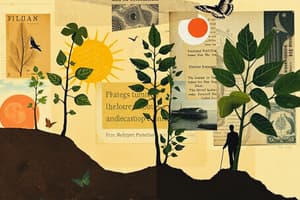Podcast
Questions and Answers
What is the primary function of chloroplasts in plant cells?
What is the primary function of chloroplasts in plant cells?
- To synthesize amino acids
- To store genetic material
- To regulate cell division
- To convert light energy into chemical energy (correct)
What is the outcome of the light-dependent reactions in the thylakoid membranes?
What is the outcome of the light-dependent reactions in the thylakoid membranes?
- Synthesis of ATP and NADPH (correct)
- Regeneration of RuBP
- Fixation of CO2
- Formation of glucose
What is the role of pigments such as chlorophyll in the light-dependent reactions?
What is the role of pigments such as chlorophyll in the light-dependent reactions?
- To absorb light energy (correct)
- To convert CO2 into glucose
- To synthesize ATP and NADPH
- To regulate the Calvin cycle
What is the byproduct of the light-independent reactions in the stroma?
What is the byproduct of the light-independent reactions in the stroma?
What is the first step in the light-independent reactions?
What is the first step in the light-independent reactions?
What is the purpose of the regeneration of RuBP in the Calvin cycle?
What is the purpose of the regeneration of RuBP in the Calvin cycle?
Flashcards are hidden until you start studying
Study Notes
Overview of Photosynthesis
- Photosynthesis is the process by which plants, algae, and some bacteria convert light energy from the sun into chemical energy in the form of organic compounds, such as glucose.
- This process occurs in specialized organelles called chloroplasts, which are present in plant cells.
Light-Dependent Reactions
- Light energy is absorbed by pigments such as chlorophyll and converted into ATP and NADPH.
- These reactions occur in the thylakoid membranes of the chloroplast and involve the following steps:
- Light absorption by pigments
- Excitation of electrons
- Transfer of electrons to electron acceptors
- Formation of ATP and NADPH
Light-Independent Reactions (Calvin Cycle)
- The energy from ATP and NADPH is used to convert CO2 into glucose.
- These reactions occur in the stroma of the chloroplast and involve the following steps:
- Carbon fixation (CO2 is fixed into a 3-carbon molecule)
- Reduction of 3-carbon molecules to form glyceraldehyde 3-phosphate (G3P)
- Regeneration of RuBP (the 5-carbon molecule that binds to CO2)
- Production of glucose from G3P
Importance of Photosynthesis
- Provides energy and organic compounds for plants to grow and develop
- Supports life on Earth by producing oxygen and food for heterotrophic organisms
- Plays a critical role in the Earth's carbon cycle and climate regulation
Factors Affecting Photosynthesis
- Light intensity and quality
- Temperature
- Water availability
- CO2 concentration
- pH and nutrient availability
Studying That Suits You
Use AI to generate personalized quizzes and flashcards to suit your learning preferences.




